Cats have been cherished companions for thousands of years, enchanting us with their elegance, independence, and playful nature. Whether you’re a lifelong cat lover or considering adopting a feline friend, understanding the different cat breeds can help you find the perfect match for your lifestyle. In this blog post, we’ll explore the top 10 cat breeds, highlighting their unique traits, appearances, and personalities. From the sleek Siamese to the charming Scottish Fold, these breeds each offer something special to feline enthusiasts.
The Enchantment of Cats
Cats have captivated human hearts and homes throughout history. From their revered status in ancient Egypt to their roles as charming companions in modern households, cats continue to intrigue and delight us. Each breed has its own unique characteristics, and knowing more about them can enhance your experience as a cat owner. Let’s dive into the top 10 cat breeds and discover what makes each one stand out.

1. Siamese
History and Origins
The Siamese cat is one of the oldest and most distinctive breeds, originating from Thailand (formerly Siam). Revered in ancient Siamese culture, these cats were considered sacred and were often kept in temples.
Appearance
Siamese cats are known for their sleek, slender bodies and striking color-pointed coats. Their large, almond-shaped blue eyes and large ears give them an elegant and expressive look. Their short, fine coat comes in several color points, including seal, chocolate, blue, and lilac.
Personality
Siamese cats are highly social, vocal, and affectionate. They enjoy interacting with their human companions and are known for their playful and curious nature. Siamese cats are intelligent and require mental stimulation, so engaging them with toys and interactive play is essential.
Care Requirements
Siamese cats have a low-maintenance coat but need regular social interaction and mental stimulation. They thrive in environments where they receive plenty of attention and playtime.
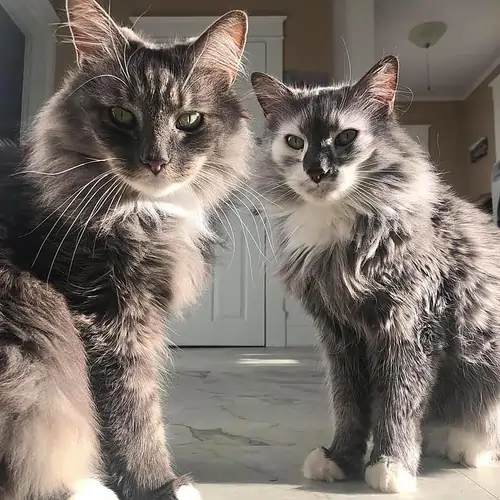
2. Maine Coon
History and Origins
The Maine Coon is one of the largest domestic cat breeds and is believed to have originated in the United States, specifically Maine. They are thought to be a natural breed that adapted to the harsh New England climate.
Appearance
Maine Coons are known for their impressive size, with males weighing between 13 to 18 pounds and females slightly smaller. They have a rugged, muscular build, tufted ears, and a long, bushy tail. Their thick, water-resistant coat is well-suited for cold weather.
Personality
Maine Coons are often described as “gentle giants.” They are friendly, sociable, and get along well with children and other pets. Despite their large size, they are playful and affectionate, often enjoying interactive play with their families.
Care Requirements
Maine Coons require regular grooming to prevent matting of their long coat. They also need a balanced diet to support their large size and active lifestyle. Regular playtime and social interaction are important for their well-being.
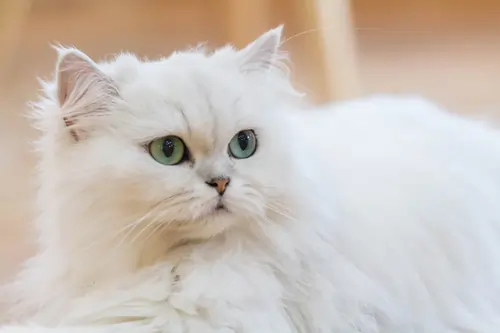
3. Persian
History and Origins
Persian cats are one of the most recognizable and ancient cat breeds, with origins tracing back to Persia (modern-day Iran). Known for their luxurious coats and flat faces, Persians have been popular among royalty and aristocrats for centuries.
Appearance
Persian cats have a distinctive round face, short nose, and large, expressive eyes. Their long, flowing coat requires regular grooming to maintain its beauty. Persians come in a wide range of colors and patterns, including solid, tabby, and bi-color.
Personality
Persians are known for their calm and laid-back demeanor. They are affectionate and enjoy a peaceful environment. While they may be less active than some other breeds, they still appreciate gentle play and attention from their owners.
Care Requirements
Persian cats need daily grooming to keep their long coat free from tangles and mats. They are also prone to certain health issues, such as respiratory problems due to their flat faces, so regular veterinary check-ups are important.

4. Bengal
History and Origins
The Bengal cat is a modern breed, developed by crossing domestic cats with the Asian leopard cat. This cross aimed to create a domestic cat with the wild appearance of a leopard while maintaining a gentle temperament.
Appearance
Bengal cats are known for their striking spotted or marbled coat, which resembles that of a wild leopard. They have a sleek, muscular build and large, expressive eyes. Bengals are medium to large in size and possess an athletic, graceful appearance.
Personality
Bengal cats are energetic, playful, and highly intelligent. They thrive on interactive play and mental challenges. Bengals are curious and enjoy exploring their environment. They form strong bonds with their owners and can be quite vocal.
Care Requirements
Bengal cats have a short, low-maintenance coat but need plenty of exercise and mental stimulation. Providing toys, climbing structures, and regular interactive playtime is essential for their happiness.

5. Scottish Fold
History and Origins
The Scottish Fold is a unique breed known for its distinctive folded ears. Originating in Scotland in the 1960s, this breed was developed from a kitten with unusual ear folds.
Appearance
Scottish Folds are characterized by their folded ears, which give them a distinctive, owl-like appearance. They have a round face, large eyes, and a medium-sized, stocky body. Scottish Folds can have both short and long coats in various colors and patterns.
Personality
Scottish Folds are sweet, easygoing, and affectionate. They enjoy being around their human companions and are generally calm and adaptable. They are playful and curious, making them wonderful family pets.
Care Requirements
Scottish Folds with short coats require minimal grooming, while those with long coats need regular brushing. Their folded ears may need occasional cleaning to prevent wax buildup. Regular veterinary check-ups are important to ensure their unique ear structure remains healthy.
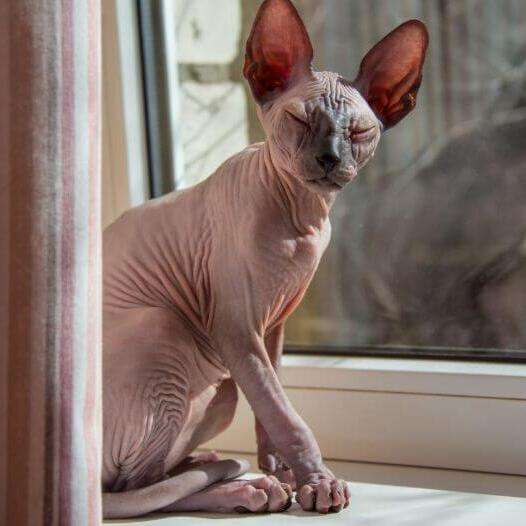
6. Sphynx
History and Origins
The Sphynx is a hairless breed that originated in the 1960s in Canada. The breed was developed through selective breeding of hairless cats and has since become known for its unique appearance and affectionate nature.
Appearance
Sphynx cats are famous for their lack of a fur coat, which makes their skin feel warm and soft to the touch. They have a muscular, medium-sized body with large, bat-like ears and prominent cheekbones. Despite their lack of fur, Sphynx cats have a variety of skin colors and patterns.
Personality
Sphynx cats are known for their friendly, outgoing, and affectionate nature. They are very social and enjoy being the center of attention. Sphynx cats are playful and curious, often engaging in interactive play with their owners.
Care Requirements
Sphynx cats require regular bathing to remove the oils that would normally be absorbed by their fur. They also need protection from extreme temperatures due to their lack of a fur coat. Sphynx cats thrive in warm, cozy environments where they can stay comfortable.

7. Ragdoll
History and Origins
The Ragdoll breed was developed in the 1960s in the United States by Ann Baker, who aimed to create a gentle, affectionate cat with striking blue eyes and a semi-long coat.
Appearance
Ragdolls are large, muscular cats with a soft, silky coat and striking blue eyes. They have a semi-long coat that is typically color-pointed, with darker colors on the ears, face, paws, and tail. Ragdolls are known for their expressive, gentle appearance.
Personality
Ragdolls are known for their docile and affectionate nature. They are often described as “puppy-like” because they enjoy following their owners around and being involved in family activities. Ragdolls are typically easygoing and get along well with children and other pets.
Care Requirements
Ragdolls require regular grooming to keep their semi-long coat free from tangles and mats. They also need a balanced diet and regular veterinary check-ups to maintain their health. Their gentle nature makes them well-suited to a variety of living environments.
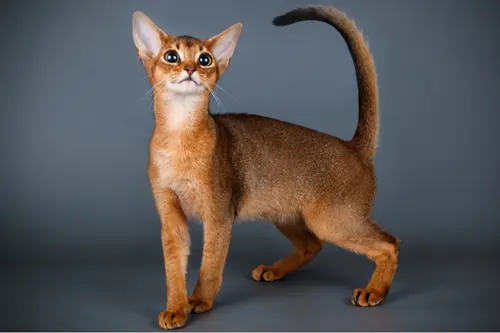
8. Abyssinian
History and Origins
The Abyssinian is one of the oldest known cat breeds, with origins believed to be in ancient Egypt. The breed is known for its distinctive ticked coat, which gives it a wild appearance.
Appearance
Abyssinians have a sleek, muscular build with a short, ticked coat that lies close to the body. Their coat colors include ruddy, red, blue, and fawn. They have large, almond-shaped eyes and a graceful, athletic appearance.
Personality
Abyssinians are energetic, playful, and highly intelligent. They are known for their curiosity and love of exploring their surroundings. Abyssinians are social cats that enjoy interactive play and thrive in environments where they can be active and engaged.
Care Requirements
Abyssinians have a low-maintenance coat that requires minimal grooming. They need regular exercise and mental stimulation to stay happy. Providing toys, climbing structures, and interactive playtime will keep them entertained and healthy.
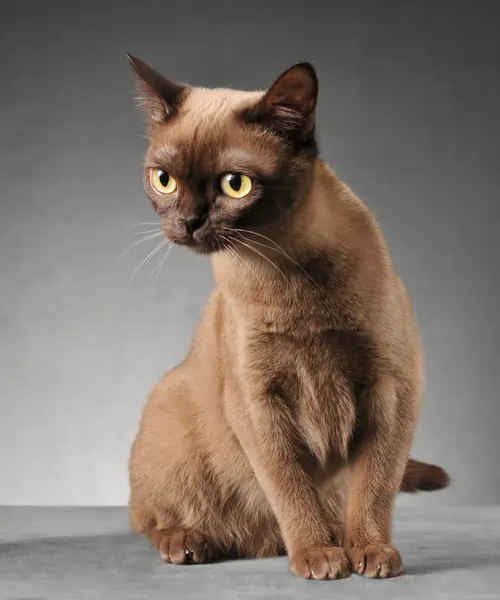
9. Burmese
History and Origins
The Burmese cat originated in Southeast Asia and was brought to the United States in the early 20th century. The breed is known for its distinctive round head and sleek, muscular body.
Appearance
Burmese cats have a compact, muscular build with a short, shiny coat that lies close to the body. They have a distinctive rounded head, large eyes, and a sweet expression. Their coat colors include sable, champagne, blue, and sable.
Personality
Burmese cats are affectionate, social, and playful. They enjoy being around their human companions and are known for their vocal nature. Burmese cats are intelligent and can be trained to perform simple tricks or play interactive games.
Care Requirements
Burmese cats have a low-maintenance coat that requires minimal grooming. They need regular social interaction and mental stimulation to keep them happy. Providing toys and engaging in interactive play will help satisfy their playful nature.

10. Somali
History and Origins
The Somali cat is closely related to the Abyssinian and is believed to have originated from the same gene pool. It was developed in the 1960s in the United States, where breeders focused on creating a long-haired version of the Abyssinian.
Appearance
Somali cats have a graceful, medium-sized body with a long, silky coat. Their coat is ticked, similar to the Abyssinian, and comes in various colors such as ruddy, red, blue, and fawn. They have large, expressive eyes and a bushy tail.
Personality
Somali cats are known for their playful, active, and curious nature. They enjoy exploring their environment and engaging in interactive play. Somali cats are social and affectionate, forming strong bonds with their human companions.
Care Requirements
Somali cats require regular grooming to maintain their long, silky coat and prevent matting. They need plenty of exercise and mental stimulation to stay happy and healthy. Providing toys and opportunities for interactive play is essential for their well-being.
Conclusion
Cats are remarkable creatures, each breed bringing its own unique charm and characteristics to our lives. Whether you’re drawn to the elegant Siamese, the gentle giant Maine Coon, or the playful Somali, there’s a breed to suit every cat lover’s preference. By understanding the traits and needs of these top 10 cat breeds, you can find a feline friend that perfectly fits your lifestyle and enriches your life with their companionship and affection.
Embrace the wonderful world of cats and enjoy the unique bond that each breed offers. Regardless of the breed, cats bring joy, love, and a touch of magic into our homes.
You may also like :



